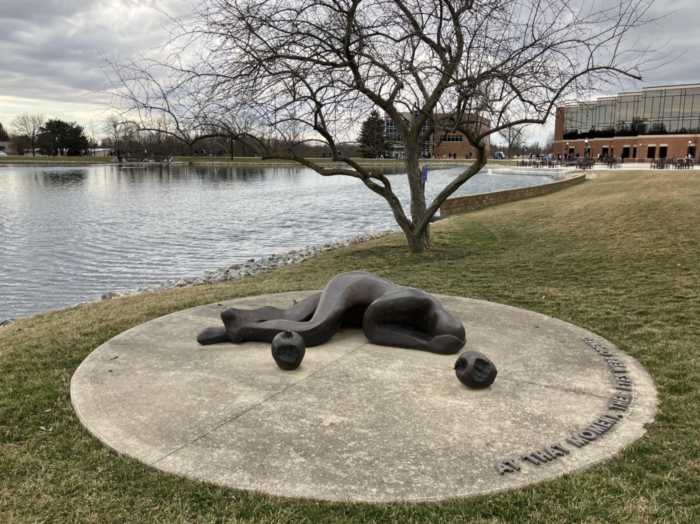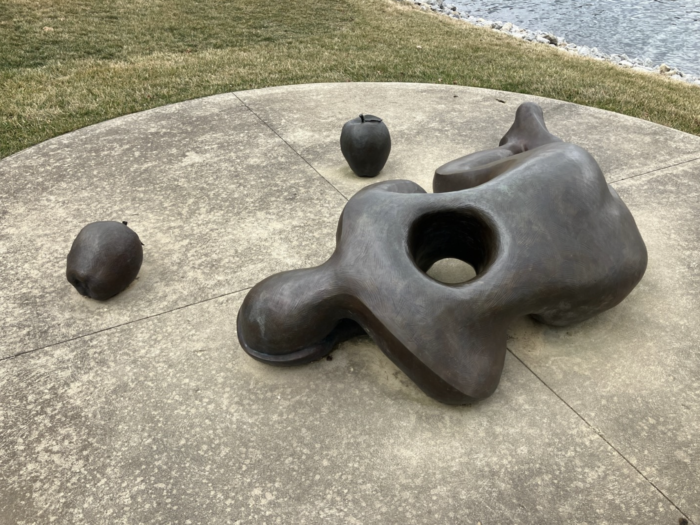
by Stephen Schuler
When I first visited Cedarville University a year ago, and I was considering whether this was a place at which I would like to teach, I was encouraged to see a thoughtfully composed sculpture on the shore of the lake. The sculpture, called Opened Eyes, is by artist James DeVries, who also designed the statue of Dr. Dixon that sits in the west foyer of the Dixon Ministry Center. But unlike the lifelike Dr. Dixon statue, the Opened Eyes sculpture uses simple lines to draw the viewer into a single moment in a familiar story. Despite the lack of vivid detail, the sculpture is well worth looking at.
The best way to view the sculpture is to come at it from the direction of the Dixon Ministry Center. As I walk westward, toward the Stevens Student Center, I first glimpse the sculpture from a distance: a large human figure is lying in a contorted position on the ground. Right behind it is a crabapple tree.
As I come closer, details emerge. There are two apples on the ground, each with a bite out of it. Immediately I know what this sculpture is about. The two apples signify the fruit of the Tree of the Knowledge of Good and Evil, which Adam and Eve ate in disobedience to God’s command. But while there are two bitten apples in the sculpture, there is only one human figure. Is this Eve, who ate first? Or is it Adam? Why is there only one fallen human and not two?
The single figure evokes Romans 5:12-17, which speaks of death coming into the world through the sin of one man. The two apples on the ground indicate that, yes, there really were two guilty humans in the historical moment. Perhaps the sculpture has excluded Eve from the picture in order to focus solely on Adam, or perhaps it has wrapped up both Adam and Eve into this single figure representing all humanity.
As I move around to the front of the sculpture, I can now read the epigraph: “At that moment, their eyes were opened.” The words clarify the precise moment that the sculpture is intended to capture. Adam and Eve have eaten the forbidden fruit. They have suddenly realized that they are naked, but they have not yet gone for the fig leaves.
I can’t help but notice a hint of irony in this epigraph. It says that his eyes were opened, yet this this figure’s face is buried in his hands. At this moment he is so ashamed of what he has done that he cannot see anything with his physical eyes at all. Sin certainly is an eye-opener, but it always inflicts a more fundamental blindness.
As I circle around to the other side of the sculpture, one more feature becomes fully visible. There is a hole in Adam’s back, and it goes all the way through. He is wounded in the heart. The core of his being has been destroyed, and every one of his descendants (save one) will be born with what we might call a heart problem.
Peering over the top of the sculpture, I can see the ground through the hole in Adam’s torso. He is, after all, made of dust (as the sculpture is made of metal), and he is about to be told by God that he will return to the ground from which he is taken. The disintegration, it seems, has already begun.

This sculpture is hardly the first work of art to depict the Fall of Man. The story has inspired all manner of literary interpretations, from the works of anonymous medieval playwrights to the greatest epic poem ever written in English, Paradise Lost by John Milton. Many visual artists, too, have created their own pictures of the events as they imagine them, and this sculpture pays homage to a particular feature of that tradition.
The way Adam is hiding his face in his hands recalls a traditional depiction of Adam and Eve’s expulsion from the Garden. In these traditional pictures, Adam and Eve are nearly always shown in two opposite poses. One of them (typically Adam) hides his face in shame. The other (usually Eve) looks either up at the sky in grief or back at the Garden in regret. Although sometimes the roles are reversed, it is normally Adam who is doing the ultimate facepalm.
But this sculpture takes that posture of shame out of its usual artistic context outside the Garden’s gate and plants it where it belongs: at the moment when the Bible says humans experienced shame for the first time. Hence this bronze Adam lies near the crabapple tree, just as the historical Adam must have first felt shame near the Tree of the Knowledge of Good and Evil.
Stepping back from the sculpture, one begins to wonder about it. If Adam’s shame and guilt are so severe, why craft a sculpture of him at all? Why is our ancestor worth looking at in this posture?
First, I think, because even in his fall he is a great man. Here, cast as a bronze figure twice the size of an ordinary son of Adam, is the tragic hero of the universe, our first father who committed the fatal error. In his presumption, he did the one thing that he knew was forbidden, and in doing so he fell. Shakespeare’s tragic heroes always die at the end of the play. This tragic hero, however, will not die physically for many years, even though the most important part of him is dead already.
This sculpture also requires us to linger for a while in a very uncomfortable part of the story. We would like, of course, to rush forward to the happy ending, whether that be the protoevangelium proclaimed over the serpent (Genesis 3:15), the resurrection of Christ, or the New Jerusalem. But in this moment of sadness, there is still a hint at the redemption to come. This man’s overwhelming shame suggests that he understands the gravity of what he has done.
This Adam is not just sorry he has been caught, for he hasn’t been caught yet. We know, of course, that his Creator is coming to confront him, and when that happens, he will tell the truth about what he has done. He will confess, and we know that confession opens the way to forgiveness (1 John 1:9). Opened Eyes is not, I think, about the worldly kind of sorrow that leads to death, but about godly sorrow that leads to repentance (2 Corinthians 7:10).
Posted in: Arts & Humanities, English, Literature, Studio Art

















